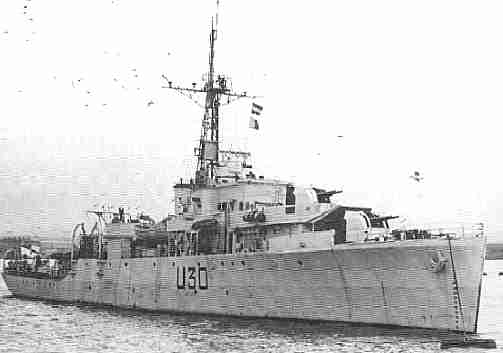- Author
- Jarrett, Hugh
- Subjects
- Biographies and personal histories, History - WW2
- Tags
-
- RAN Ships
- None noted.
- Publication
- June 2003 edition of the Naval Historical Review (all rights reserved)
Much the same as between the Wars, post WW2 saw the Royal Navy concentrated in the Mediterranean, based on Malta and Gibraltar.
IN 1951 I WAS ON EXCHANGE SERVICE in the Royal Navy and serving as Flotilla Gunnery Officer in the flotilla leader HMS Mermaid in the elite 2nd Frigate Squadron, Mediterranean Fleet.

On one occasion, we called at Taranto where we anchored, and being senior ship, we received a call from the Official del Guarda, a fine looking Lieutenant, who was received with proper ceremony and piped on board and taken to our Captain, with whom he spent some time discussing arrangements for our visit.
At 1030, when ‘Stand Easy’ was piped, I repaired to the wardroom for morning tea, and on entering I found him talking to our officers, who rose while I was introduced to him which he proffered his hand and said – ‘G’day mate – how’s your rotten form?’ I was astonished and responded with a laugh and said – ‘Where did you learn to speak Orstrilian like that?’
‘Behind the bloody wire at Boney-bloody-gilla!’ I was dumbfounded and at the same time highly amused at all this and determined to get to his story, and sat down with him and delved into his background.
He was a survivor of a submarine who was brought to Australia and interned in Bonegilla Internment Camp, which was guarded by members of the VDC, mostly soldiers too old for active service. He quickly discovered that some internees escaped but were always recaptured and thrown into special cells. He noted that the escapees were recaptured in the scrub by a ring of soldiers thrown out around the camp at a radius calculated from the time the escapee was estimated to have escaped.
He also improved his English by talking to the guards and acquiring a strong ‘Strine’ version. By talking to recovered escapees, he estimated the period it took for the radial guard to be set up around the camp and started training to run further in the same time.
He let it be known that he was an Olympic athlete (which he was) and started training by running around the playing field, and kept at it until he could run non-stop for a much longer period than it took for the radius guard to be set up.
And so he trained until one day he was given the perfect job – painting white the stones which lined the paths and tracks around the camp – a sight which the Army seems to love. As they put it – ‘If it moves salute it – if it doesn’t paint it white’. By carefully timing his task, he painted his way past the entrance, past the guard-room and was painting the stones literally outside the camp when everything came to a stop for the ‘Changing of the Guard’. When all were watching the simple ceremony he put down the paintbrush and slipped off unseen into the scrub and ran flat out for well over ninety minutes through thick scrub before easing down, quite confident that the cordon was set up behind him.
Eventually he came out of the bush at a road cutting and found himself looking down at two men struggling unsuccessfully to start the engine of a farm truck. So he came out of cover and approached them. There was no doubt as to where he came from, wearing as he did a purple shirt with large white letters ‘POW’ across the back.
Nevertheless they asked him if he knew anything about engines, and being a submariner, he assured them he knew a bit and promptly started it for them. Then they surprised him by asking if he wanted a job?
They took him in the truck to a property up in the hills well away from any neighbours, which was run by a lonely old man who took him on immediately, and here he stayed until the war ended. He was given a small hut hidden in the bush and a shotgun to augment food with rabbits, and every Saturday the boss drove into the nearest town for provisions and brought back cigarettes and beer etc for his happy labourer.




